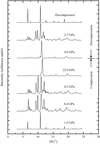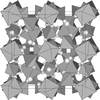issue contents
April 2001 issue

Cover illustration: The structure of Pu31Pt20 [D. T. Cromer & A. C. Larson (1977). Acta Cryst. B33, 2620-2627] viewed nearly perpendicular to a Pu, Pt disc (10 Å thick and 50 Å in diameter) down [111]. Details of the structure were taken from the intermetallics crystal structure database CRYSTMET® using the Materials ToolKit graphics software from Toth Information Systems, Inc.
research papers
Download citation


Download citation


The structure of potassium dinitramide (KDN) has been refined from X-ray diffraction data in the temperature range 85–298 K. The thermal expansion is significantly anisotropic and correlated to the atomic displacement parameters. A rigid-body analysis of the dinitramide anion was carried out. The variation of thermal motion with temperature indicates anharmonicity in the mean field potential.
An isotropic distortion parameter has been defined that quantifies the departure of the anion skeleton of a crystal from ideal closest-packing. Analysis of the variation in this parameter for a variety of rock-forming minerals at various temperatures and pressures elucidates the important role of anion–anion interactions during expansion and compression.
Download citation


Download citation


Structural, multipole and orbital analyses of the electron density in the rutile-type compounds CoF2 and ZnF2 have been performed using synchrotron X-ray data.
Download citation


Download citation


Structure factors for the Er3Al5O12 and Yb3Al5O12 garnets were measured with synchrotron X-radiation at room temperature. Approximate difference electron density symmetry around the rare-earth atoms was found to reflect that of the cation geometry, emphasizing the importance of second nearest-neighbor interactions.
Download citation


Download citation


The structure of Tl2MoO4 at 293 K has been refined and compared to the structure at 350 K. Second-harmonic generation measurements and symmetry mode analysis have been performed.
The antifluorite Na2S, disodium sulfide, undergoes, under pressure, two phase transitions adopting the anticotunnite and the Ni2In-type structures. The latter is just the structure which presents the cation array in the high-temperature phases of Na2SO4. An equivalence between oxidation and pressure is established, in the sense that both stabilize the Ni2In-type structure as if the Na and S atoms were recognized in spite of being embedded in an oxygen matrix.
Download citation


Download citation


KTa O3, an oxide bronze, has been synthesized by electrolytic crystallization. The high-resolution anharmonic crystal structure refinement reveals the presence of Ta2 dumb-bells in the KTaO3 matrix, which explain the semiconductor property.
O3, an oxide bronze, has been synthesized by electrolytic crystallization. The high-resolution anharmonic crystal structure refinement reveals the presence of Ta2 dumb-bells in the KTaO3 matrix, which explain the semiconductor property.
The structures of a number of cubic silicate garnets at ambient pressure and under compression have been investigated using first-principles pseudopotential calculations.
The structure of two intercalated compounds VOPO4–thf and VOPO4–DEG were determined by a combination of high-resolution synchrotron powder diffraction and molecular modelling. Both intercalates exhibit the same type of orientational disorder as observed in VOPO4 intercalated with water.
The crystal structure of the monoclinic form of 2,2-dihydroxymethylbutanoic acid (C6H12O4) has been determined ab initio using synchrotron radiation powder diffraction data. A partial direct method soluition was completed using Monte Carlo techniques.
Download citation


Download citation


Soft C—H⋯O hydrogen bonds link molecules of substituted diaryl sulfones into aggregates which can be zero-, one-, two- or three-dimensional.
Download citation


Download citation


3,5-Dinitrobenzoic acid forms salt-type 2:1 adducts with a range of organic diamines. The ions are linked into three-component aggregates by N—H⋯O hydrogen bonds, and these aggregates can be further linked by combinations of N—H⋯O and C—H⋯O hydrogen bonds into continuous arrays which may be one-, two- or three-dimensional.
Download citation


Download citation


Accurate X-ray and neutron structures of the five crystalline methyl pentofuranosides allow for detailed investigation of furanoside ring geometry.


 journal menu
journal menu




























